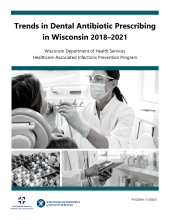Antimicrobial Stewardship: Resources for Health Care Providers
Understanding the basic tenets of antimicrobial prescribing is critical for all health care providers prescribing and managing antibiotics for patients. While antibiotics can be beneficial for patients with bacterial infections, they are not effective for treating viral or fungal infections. Side effects from antibiotics, such as affecting other bacteria in the body or adverse reactions, are common. Furthermore, overprescribing of antibiotics has led to a worldwide problem with antibiotic-resistant bacteria. Antimicrobial resistance can lead to difficulties in treating a patient’s condition and sometimes serious, life-threatening illness.
Oversight of antimicrobial prescribing, through antimicrobial stewardship (AS) programs, is essential to help guide the benefits and risks of antimicrobial treatment. AS programs combine data review and prescriber education to reinforce evidence-based practices among clinicians and more effective use of antibiotics. Several national organizations, including CMS (Centers for Medicaid & Medicare Services), have mandated that hospitals and nursing homes implement AS programs. Many stewardship programs utilize CDC’s (Centers for Disease Control and Prevention) Core Elements of Antibiotic Stewardship as a roadmap.
Join a stakeholder group
Are you a health care provider interested in contributing to antimicrobial stewardship efforts in Wisconsin? There are currently two active stakeholder groups open to health care providers: Wisconsin Antimicrobial Stewardship Steering Committee, and the Wisconsin Community Hospital stakeholder group. Contact the Healthcare-Associated Infections (HAI) Prevention Program’s Antimicrobial Stewardship Coordinator, Dr. Lindsay Taylor at Lindsay.Taylor@dhs.wisconsin.gov for more information.
Resources by health care setting
Read setting-specific information, statistics, and resources for health care providers by expanding the tabs below.
General medical conditions continue to grow more complex over time, causing patients to become hospitalized with complicated care. There is also a rising trend of elderly patients admitted to the hospital with multiple medical problems. Surveys have shown that 50% of all hospitalized patients receive an antibiotic during their stay. Per the CDC Core Elements of Hospital Antibiotic Stewardship Programs, about 30% of all antibiotics prescribed in US acute care hospitals are either unnecessary or suboptimal. In Wisconsin, 100% of acute care hospitals reported adopting all seven inpatient core elements in 2022.
Resources for inpatient providers
- CDC Core Elements of Hospital Antibiotic Stewardship Programs: Review the core elements of hospital antibiotic stewardship programs and implementation resources for hospitals.
- CDC Implementation of Antibiotic Stewardship Core Elements at Small and Critical Access Hospitals: Small and critical access hospitals face unique challenges to implementing the core elements such as limited staffing, infrastructure, and resources. The CDC shares options that may help small and critical access hospitals ensure each of the core elements are implemented in their facility. Each facility is unique, and therefore flexibility and tailoring implementation to the facility’s specific needs is essential.
In recent years, an increasing numbers of residents have been admitted to long-term care facilities (LTCFs) with complicated conditions. Some types of care and treatments that may have been provided in an inpatient setting years ago are now provided in nursing homes or assisted living facilities. Per the CDC, antibiotics are among the most frequently prescribed medications in nursing homes, with up to 70% of residents receiving one or more antibiotic courses per year. Yet, per CDC Core Elements of Antibiotic Stewardship for Nursing Homes, studies have shown that 40–75% of antibiotics prescribed in nursing homes may be unnecessary or inappropriate.
While not all nursing homes in Wisconsin report these data, in both 2021 and 2022, 72% of nursing homes reporting these data indicated that they had adopted all seven nursing home AS core elements. You can learn more about efforts to promote antibiotic stewardship in LTCF by visiting the HAIs in LTC Coalition webpage.
Resources for long-term care providers
- Antibiotic Stewardship in LTC Facilities: Where Do You Start?: Watch a video describing AS fundamentals from Lake Superior Quality Innovation Network (formerly known as Lake Superior Quality Innovation Network).
- CDC Core Elements of Antibiotic Stewardship for Nursing Homes: Review the core elements for nursing home AS programs.
- CDC Antimicrobial Stewardship Implementation Resources for Nursing Homes: See fact sheets and additional resources on leadership accountability, drug expertise, and more.
- Toolkit to Improve Antibiotic Use in LTC: View education resources and tools on improving antibiotic use in LTC from the Agency for Healthcare Research and Quality (AHRQ).
- Wisconsin LTC Education Webinar Series: View a library of educational webinars on a variety of infection prevention and AS topics specific to the LTC setting.
- Bacteria in Urine Does Not Equal UTI, P-03737 (PDF): This fact sheet explains why the majority of nursing home residents with asymptomatic pyuria (ASB) should not be treated.
- Wisconsin Long-Term Care Urinary Tract Infection (UTI) Toolkit: See resources and tools to standardize the assessment and communication of findings in residents experiencing a change in condition where UTI is suspected; promote the use of active monitoring, delayed urine testing, and delayed antibiotic treatment among residents with low UTI risk; and promote the appropriate use of antibiotics (drug, dose, duration) in residents with high UTI risk.
Eighty to ninety percent of the volume of human antibiotic use occurs in the outpatient setting. Per the CDC Core Elements of Outpatient Antibiotic Stewardship, at least 30% of antibiotics prescribed in U.S. doctors’ offices and emergency departments are unnecessary. The majority of infectious disease conditions in the outpatient setting are caused by viral infections for which antibiotics have no effect.
Antibiotic stewardship efforts in the outpatient setting help balance the need for effective treatment of bacterial infections while reducing prescribing for viral illnesses. Many providers around the state of Wisconsin are tracking current prescribing practices and offering targeted education to further advance this important initiative.
To better understand the current state of outpatient antibiotic use in Wisconsin, the DHS HAI Prevention Program partnered with the Wisconsin Health Information Organization (WHIO) to develop a series of outpatient antibiotic use measures. The Trends in Outpatient Antibiotic Prescribing in Wisconsin 2018–2021, P-03383 (PDF) report uses these measures to describe trends in outpatient antibiotic use and identify additional targets for improvement.
Resources for outpatient providers
- CDC Core Elements of Outpatient Antibiotic Stewardship: Review the core elements of AS in outpatient settings.
- CDC MITIGATE Toolkit: See strategies to implement AS in emergency department and urgent care settings.
- CDC Print Materials on Antibiotic Prescribing and Use: See posters, infographics, handouts, and other downloadable patient and provider education materials.
- CDC Treatment Recommendations for Health Care Professionals: See antibiotic prescribing information for clinicians.
- Improving Antibiotic Stewardship Video Series: Watch educational videos on improving AS in the outpatient setting from the Lake Superior Quality Innovation Network.
- Trends in Outpatient Antibiotic Prescribing in Wisconsin, 2018–2021, P-03383 (PDF): View Wisconsin outpatient antibiotic prescribing trends and data from Wisconsin DHS.
- DHS Viral Prescription Pad (PDF): Complete and share this prescription pad with patients with symptoms that indicate viral respiratory illnesses. Use the viral prescription pad to initiate conversations with patients on when antibiotics are not needed, and to provide patients with steps they can take to help themselves feel better. Viral Prescription Pad in Spanish (PDF).
- Sample patient assessment scripts: Use the following scripts from Wisconsin DHS to assess patients who present with various conditions.
Several dental studies noted findings of up to 85% of antibiotic prescriptions as “suboptimal” or “not indicated.”
Dentists also account for 1 in 10 antibiotic prescriptions in the outpatient setting, which makes them the third to fourth highest antibiotic prescribers by volume following family medicine, internal medicine, and pediatrics.
The scope of antibiotic prescribing and use in the dental setting makes it an ongoing area of focus for antibiotic use tracking and evidence-based prescribing reduction.
Resources for dental and oral health providers
- Acute Dental Pain Management (PDF): Read a report from the American Dental Association (ADA) with guidelines for antibiotic use for the urgent management of dental pain and swelling.
- Antibiotics Before Dental Procedures in Patients with Artificial Joints, P-03155 (PDF): Use and share this document when having discussion about antibiotic use with patients with artificial joints.
- Antibiotic Stewardship Resources for Dental Settings: View a fact sheets, online training modules, tools, and guidance.
- Dentists Are Antibiotic Stewards, P-03009 (PDF): Download and customize a Wisconsin DHS poster for your dental office.
- Oral Health Antibiotic Toolkit, P-03109 (PDF): See information from Wisconsin DHS to make informed and evidence-based antibiotic prescribing decisions and effectively communicate them with patients and medical team members.
- Prophylaxis for Cardiac Conditions: Review antibiotic prophylaxis recommendations from the American Heart Association to prevent viridans group streptococcal infective endocarditis in cardiac patients undergoing invasive procedures.
- Trends in Dental Antibiotic Prescribing in Wisconsin, 2018–2021, P-03383a (PDF): View Wisconsin dental antibiotic prescribing trends and data from DHS.
The right drug, right dose, de-escalation of therapy, and duration of therapy are all important concepts in establishing a successful AS practice. Pharmacists are trained in optimizing drug regimens and potential adverse effects, making them key members of AS activities across all areas where antibiotics are prescribed. Drug expertise is a component across all the AS core elements.
Resources for pharmacists
Achieving Core Measure Success in the Community Pharmacy Setting: Watch the educational video on improving AS in the pharmacy setting from the Lake Superior Quality Innovation Network.
Resources for providers in any setting
Trainings, posters, fact sheets, and more
- CDC Antibiotic Stewardship Training Course: Complete CDC’s Antibiotic Stewardship Training Plan with modules on antibiotic resistance, prescribing practices, and more.
- CDC Educational Resources for Health Care Professionals: View and download posters, fact sheets, prescription pads, and more.
- DHS Viral Prescription Pad (PDF): Complete and share this prescription pad with patients with symptoms that indicate viral respiratory illnesses. Use the viral prescription pad to initiate conversations with patients on when antibiotics are not needed, and to provide patients with steps they can take to help themselves feel better. Viral Prescription Pad in Spanish (PDF).
- DHS social media graphic: View, download, and share the "Feeling Sick" graphic with your patients. The graphic outlines when antibiotics may be needed. The "Feeling Sick?" graphic is available in Spanish.
De-labeling penicillin allergies
- CDC Clinical Features of Penicillin Allergy for Health Care Professionals: Read information and statistics on evaluating penicillin allergy diagnoses.
- De-Labeling Penicillin Allergies: Watch an educational video from About Health on the importance of assessing patient penicillin allergy labels.
Resources for medical and veterinary students
Find educational information on AS for future health professionals.




